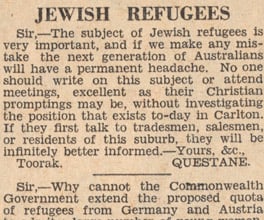The Holocaust
The National Socialist (Nazi) Party came to power in Germany in the 1930s, with an open policy of hatred for the nation’s Jewish citizens. Jews had lived at the heart of German culture for centuries, and had succeeded in business and professions such as law and medicine.
The Nazi leader Adolf Hitler was able to exploit a popular feeling that Jews were not ‘real’ Germans. He falsely blamed them for Germany’s economic and political problems. The Nazi government began to systematically persecute Jews, seizing their property and closing down their businesses. Large numbers of German Jews sought refuge in other countries.
At the time, there was very little migration to Australia. The 1930s were a period of economic depression, and the government had restricted migration because of a lack of jobs. The question of whether Jewish refugees should be allowed to settle in Australia was widely debated, with strong opinions on both sides.
In 1938 an international conference was held in Evian, France, to discuss the problem of large numbers of Jewish refugees from the Holocaust. At this conference, the Australian delegate spoke against allowing Jewish refugees to settle in Australia:
As we have no real racial problem, we are not desirous of importing one by encouraging any scheme of large-scale foreign migration...
- Thomas Walter White
Thomas Walter White, Speech Transcript, Australian delegate to the Evian Conference.
Before the war, Australian governments had always favoured immigration from Britain, because they believed the British would fit into Australian society more easily. But after the war, Australia began to seek immigrants from countries such as Italy, Greece, Poland, and the Netherlands.
During the Jewish refugee crisis of the 1930s, before the modern state of Israel had been founded, many individuals suggested areas that could be a new Jewish homeland. Some of these were in Australia, such as the Kimberley region in Western Australia, Melville Island off the north coast, and even the south-west coast of Tasmania. None of these plans received serious support.
However, other countries were making an effort to take refugees, and so the Australian government felt pressured to do the same. They agreed to take 15,000 Jewish refugees over three years.
Nazi concentration camps had existed since 1933, but in 1942 the Nazis drew up their plan for the ‘Final Solution’: killing every Jew within their power. New camps were built in German-occupied territory and their existence was kept a secret. Isolated reports about them reached the outside world, by Germans who resisted the Nazi regime from within.
It was only when the Nazis were defeated and the camps were liberated by American, English and Russian troops that the full horror was revealed to the world. More than six million Jews had perished. The liberating troops forced local German civilians to walk through the camps, to witness the dead and in some cases, to bury them.
After the war, the Australian government decided that the country’s small population made it vulnerable to attack, and official policy was to increase the population as quickly as possible. They encouraged large numbers of Europeans to settle in Australia, but were still reluctant to allow mass Jewish migration. They believed that Jews did not blend in, and immediately after the war, only allowed a small annual quota of 2,000 Jews to emigrate.











